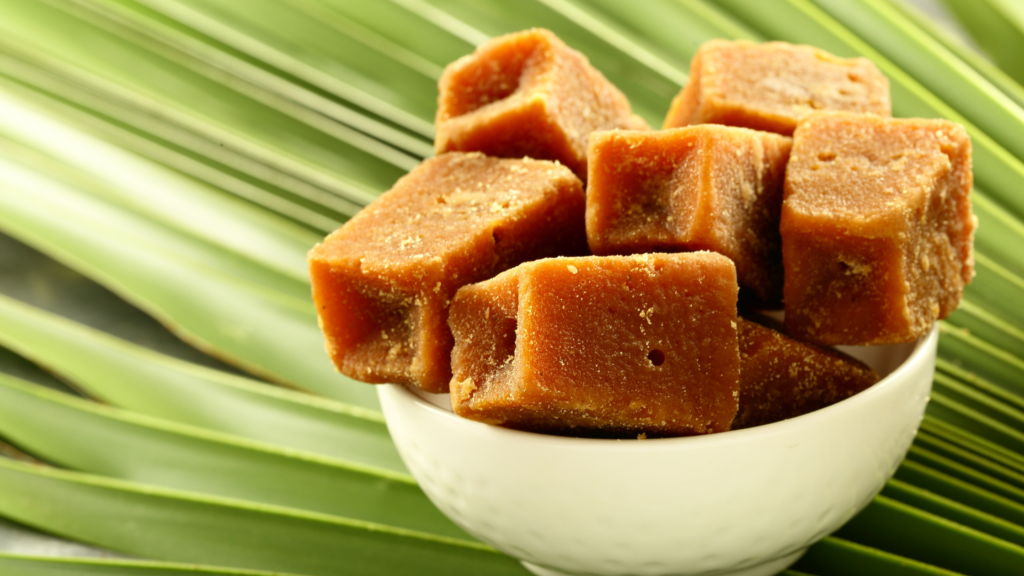You want to provide your furry friend with a healthy and balanced diet as a dog owner. However, with so many human foods, knowing what’s safe and what’s not for your four-legged companion cannot be easy. One food that you may be wondering about is jaggery. Jaggery is a popular sweetener in many traditional cuisines, but is it safe for dogs to eat? This article will explore whether can dogs eat jaggery?, Is Jaggery Good for Dogs to eat?, the potential benefits and risks, and some alternative treats you can offer your pup.
What is Jaggery?

Jaggery is a traditional sweetener made from sugarcane juice or palm sap. It is widely used in many parts of the world, particularly in South and Southeast Asia, Africa, and Latin America.
Jaggery is often used as a substitute for sugar and is known for its distinct flavor and caramel-like taste. It is also commonly used in Ayurvedic medicine as a natural remedy for various ailments.
Jaggery is typically sold in blocks or cones. It can range in color from light golden to dark brown, depending on the production method and the type of raw material used.
While jaggery is a popular ingredient in many human foods, you may wonder if it is safe for dogs to eat.
Can Dogs Eat Jaggery? Is Jaggery Good for Dogs?

Can we give jaggery to dogs? While jaggery is generally safe for dogs to consume in small amounts, it should be in moderation. Jaggery is a natural sweetener and contains many essential minerals and vitamins, including iron, calcium, and magnesium.
However, it is also high in calories and can lead to weight gain and obesity if consumed in large quantities.
Additionally, jaggery can cause a spike in blood sugar levels. It may not be suitable for dogs with diabetes or other health conditions requiring careful blood sugar management.
Suppose you plan to feed your dog jaggery. In that case, it’s important to do so in moderation and consult your veterinarian first, especially if your dog has any underlying health conditions.
Also Read: Why Is My Dog Shaking After Vaccination? Best Guide
Benefits of Jaggery for Dogs
Jaggery can provide several potential benefits for dogs when consumed in moderation.
One of the main benefits of jaggery is that it contains many essential minerals and vitamins, including iron, calcium, and magnesium, which are important for maintaining good health.
Jaggery is also a natural sweetener and can be used as a healthier alternative to processed sugar in homemade dog treats or as a flavor enhancer for your dog’s food.
Additionally, jaggery may help with digestion by promoting the growth of healthy gut bacteria, which can aid in nutrient absorption and reduce the risk of digestive issues like constipation and diarrhea.
However, it’s important to note that the benefits of jaggery for dogs have yet to be extensively studied, and feeding jaggery to your dog should be done in moderation and under the guidance of a veterinarian.
Risks of Feeding Jaggery to Dogs
While jaggery can offer some potential benefits for dogs when consumed in moderation, it can also pose some risks if fed excessively.
One of the main risks of feeding jaggery to dogs is that it is high in calories and can contribute to weight gain and obesity, leading to various health issues.
Additionally, jaggery is a natural sweetener and can cause a spike in blood sugar levels, which can be problematic for dogs with diabetes or other health conditions that require careful management of blood sugar levels.
Furthermore, if your dog consumes large amounts of jaggery, it can lead to gastrointestinal upset, including diarrhea and vomiting.
As with any new food or treat, it’s important to introduce jaggery gradually and in small amounts to monitor your dog’s reaction and prevent any adverse effects.
Suppose you have any concerns or questions about feeding jaggery to your dog. In that case, it’s always best to consult your veterinarian first.
Can Jaggery be Given to Puppies?

Giving jaggery or any sweet treats to puppies is generally not recommended.
Puppies have sensitive digestive systems, and their dietary needs differ from those of adult dogs.
Feeding puppies sugary treats like jaggery can upset their stomach and cause diarrhea or other digestive issues.
Additionally, puppies are more likely to develop dental problems, and sugary treats can contribute to tooth decay and gum disease.
It’s important to provide puppies with a balanced diet that meets their nutritional needs and consult your veterinarian about any dietary changes or treats you plan to offer your puppy.
Can Jaggery Cause Diabetes in Dogs?
No direct evidence suggests that jaggery can cause diabetes in dogs. However, as a natural sweetener, jaggery is high in calories.
It can contribute to weight gain and obesity, risk factors for developing diabetes.
Additionally, consuming excessive amounts of jaggery can cause a spike in blood sugar levels, which can be problematic for dogs with diabetes or other health conditions requiring careful blood sugar management.
Therefore, it’s important to feed jaggery to your dog in moderation and consult with your veterinarian if you have any concerns about your dog’s blood sugar levels.
It’s also important to note that if your dog is already diagnosed with diabetes, jaggery should be avoided or given only under the guidance of a veterinarian.
What to Do if Your Dog Eats Jaggery?
If your dog accidentally eats jaggery, there is generally no need to panic. In most cases, a small amount of jaggery is unlikely to cause any harm to your dog.
However, suppose your dog has consumed much jaggery or exhibits signs of distress or illness. In that case, it’s important to contact your veterinarian right away.
Signs of jaggery toxicity in dogs may include vomiting, diarrhea, abdominal pain, lethargy, and loss of appetite.
Your veterinarian may recommend monitoring your dog’s condition at home or bringing them in for an evaluation, depending on the severity of the symptoms.
In any case, it’s always best to avoid caution and seek veterinary care if you have any concerns about your dog’s health after consuming jaggery.
Is Palm Jaggery Good for Dogs?

Palm jaggery, like regular jaggery, can offer some potential benefits for dogs when consumed in moderation.
Palm jaggery is made from the sap of palm trees. It is a healthier alternative to regular jaggery as it contains more nutrients and minerals.
It is a rich source of iron, calcium, and magnesium, which can help support your dog’s bone health and overall well-being.
Palm jaggery is also known to have anti-inflammatory properties and can help alleviate pain and inflammation in dogs.
However, as with any new food or treat, it’s important to introduce palm jaggery gradually and in small amounts to monitor your dog’s reaction and prevent any adverse effects.
Suppose you have any concerns or questions about feeding palm jaggery to your dog. In that case, it’s always best to consult your veterinarian first.
Alternatives to Jaggery for Dogs
If you’re looking for healthy and safe alternatives to jaggery for your dog, there are several options. Here are some alternatives to consider:
- Fresh Fruits: Fresh fruits are a great source of natural sugars and can be healthy and tasty dog treats. Some safe and healthy fruits for dogs include bananas, blueberries, apples, and strawberries.
- Carrots: Carrots are a low-calorie treat high in fiber, vitamin A, and other essential nutrients. They can help improve your dog’s digestion and promote healthy teeth and gums.
- Peanut Butter: Peanut butter is a good protein and healthy fats source and can be a tasty and nutritious dog treats. Just make sure to choose a brand that does not contain xylitol, which is toxic to dogs.
- Homemade Treats: You can also make healthy treats for your dog using sweet potatoes, oats, and lean proteins like chicken or turkey.
Remember to introduce or treat any new food gradually and in moderation to avoid digestive issues or other adverse effects. Always consult your veterinarian before making significant changes to your dog’s diet.
How to Safely Introduce New Foods to Your Dog
Introducing new foods to your dog’s diet can be a fun and healthy way to offer variety and nutrients.
However, it’s essential to introduce fresh foods safely to avoid digestive upset or other adverse reactions. Here are some tips for safely introducing new foods to your dog:
- Start Slowly: When introducing new foods, start with a small amount and gradually increase the quantity over several days. This helps your dog’s digestive system adjust to the fresh food slowly.
- Monitor Your Dog’s Reaction: Keep a close eye on your dog’s reaction to the new food. Look for signs of digestive upset, such as vomiting, diarrhea, or other unusual behavior or symptoms.
- Keep It Simple: Avoid feeding your dog multiple new ingredients at once when introducing fresh foods. Stick to one new food at a time to identify potential allergies or intolerances.
- Choose Healthy Foods: Make sure to choose healthy foods that are safe and appropriate foods for dogs. Avoid feeding your dog foods that are toxic or high in fat, sugar, or salt.
- Consult Your Veterinarian: It’s always a good idea to consult your veterinarian before introducing new foods to your dog, especially if your dog has any underlying health issues or dietary restrictions.
Following these tips, you can safely introduce new foods to your dog and offer a varied and nutritious diet.
Also Read: Can Dogs Sense Negative Energy? Hidden Power of Canine Intuition
Final Thoughts on Feeding Jaggery to Dogs
While jaggery is not toxic to dogs, it’s not a necessary or recommended part of their diet.
Feeding your dog too much jaggery can lead to digestive upset, obesity, and dental issues.
Many healthy and safe alternatives to jaggery can give your dog the necessary nutrients and treats without any potential risks.
Remember, when introducing new foods or treats to your dog, always do so gradually and in moderation to avoid any adverse effects.
Consult with your veterinarian if you have any concerns about your dog’s diet or suspect it has eaten something it shouldn’t have.







